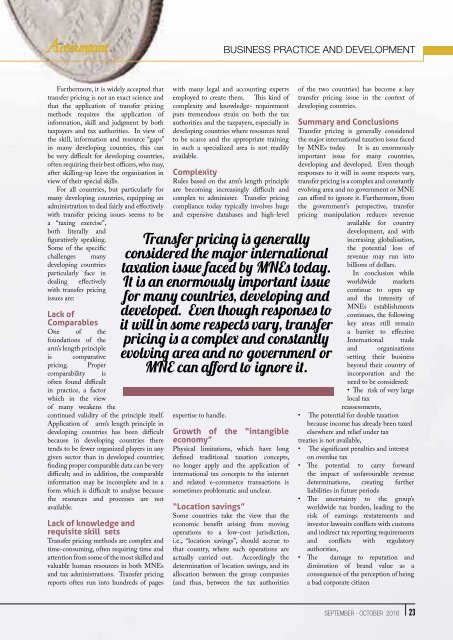The Accountant Sep-Oct-2016
Create successful ePaper yourself
Turn your PDF publications into a flip-book with our unique Google optimized e-Paper software.
Business Practice and Development<br />
Furthermore, it is widely accepted that<br />
transfer pricing is not an exact science and<br />
that the application of transfer pricing<br />
methods requires the application of<br />
information, skill and judgment by both<br />
taxpayers and tax authorities. In view of<br />
the skill, information and resource “gaps”<br />
in many developing countries, this can<br />
be very difficult for developing countries,<br />
often requiring their best officers, who may,<br />
after skilling‐up leave the organisation in<br />
view of their special skills.<br />
For all countries, but particularly for<br />
many developing countries, equipping an<br />
administration to deal fairly and effectively<br />
with transfer pricing issues seems to be<br />
a “taxing exercise”,<br />
both literally and<br />
figuratively speaking.<br />
Some of the specific<br />
challenges many<br />
developing countries<br />
particularly face in<br />
dealing effectively<br />
with transfer pricing<br />
issues are:<br />
Lack of<br />
Comparables<br />
One of the<br />
foundations of the<br />
arm’s length principle<br />
is comparative<br />
pricing. Proper<br />
comparability is<br />
often found difficult<br />
in practice, a factor<br />
which in the view<br />
of many weakens the<br />
continued validity of the principle itself.<br />
Application of arm’s length principle in<br />
developing countries has been difficult<br />
because in developing countries there<br />
tends to be fewer organized players in any<br />
given sector than in developed countries;<br />
finding proper comparable data can be very<br />
difficult; and in addition, the comparable<br />
information may be incomplete and in a<br />
form which is difficult to analyse because<br />
the resources and processes are not<br />
available.<br />
Lack of knowledge and<br />
requisite skill‐sets<br />
Transfer pricing methods are complex and<br />
time‐consuming, often requiring time and<br />
attention from some of the most skilled and<br />
valuable human resources in both MNEs<br />
and tax administrations. Transfer pricing<br />
reports often run into hundreds of pages<br />
with many legal and accounting experts<br />
employed to create them. This kind of<br />
complexity and knowledge‐ requirement<br />
puts tremendous strain on both the tax<br />
authorities and the taxpayers, especially in<br />
developing countries where resources tend<br />
to be scarce and the appropriate training<br />
in such a specialized area is not readily<br />
available.<br />
Complexity<br />
Rules based on the arm’s length principle<br />
are becoming increasingly difficult and<br />
complex to administer. Transfer pricing<br />
compliance today typically involves huge<br />
and expensive databases and high‐level<br />
Transfer pricing is generally<br />
considered the major international<br />
taxation issue faced by MNEs today.<br />
It is an enormously important issue<br />
for many countries, developing and<br />
developed. Even though responses to<br />
it will in some respects vary, transfer<br />
pricing is a complex and constantly<br />
evolving area and no government or<br />
MNE can afford to ignore it.<br />
expertise to handle.<br />
Growth of the “intangible<br />
economy”<br />
Physical limitations, which have long<br />
defined traditional taxation concepts,<br />
no longer apply and the application of<br />
international tax concepts to the internet<br />
and related e‐commerce transactions is<br />
sometimes problematic and unclear.<br />
“Location savings”<br />
Some countries take the view that the<br />
economic benefit arising from moving<br />
operations to a low‐cost jurisdiction,<br />
i.e., “location savings”, should accrue to<br />
that country, where such operations are<br />
actually carried out. Accordingly the<br />
determination of location savings, and its<br />
allocation between the group companies<br />
(and thus, between the tax authorities<br />
of the two countries) has become a key<br />
transfer pricing issue in the context of<br />
developing countries.<br />
Summary and Conclusions<br />
Transfer pricing is generally considered<br />
the major international taxation issue faced<br />
by MNEs today. It is an enormously<br />
important issue for many countries,<br />
developing and developed. Even though<br />
responses to it will in some respects vary,<br />
transfer pricing is a complex and constantly<br />
evolving area and no government or MNE<br />
can afford to ignore it. Furthermore, from<br />
the government’s perspective, transfer<br />
pricing manipulation reduces revenue<br />
available for country<br />
development, and with<br />
increasing globalisation,<br />
the potential loss of<br />
revenue may run into<br />
billions of dollars.<br />
In conclusion while<br />
worldwide markets<br />
continue to open up<br />
and the intensity of<br />
MNEs establishments<br />
continues, the following<br />
key areas still remain<br />
a barrier to effective<br />
International trade<br />
and organizations<br />
setting their business<br />
beyond their country of<br />
incorporation and the<br />
need to be considered:<br />
• <strong>The</strong> risk of very large<br />
local tax<br />
reassessments,<br />
• <strong>The</strong> potential for double taxation<br />
because income has already been taxed<br />
elsewhere and relief under tax<br />
treaties is not available,<br />
• <strong>The</strong> significant penalties and interest<br />
on overdue tax<br />
• <strong>The</strong> potential to carry forward<br />
the impact of unfavourable revenue<br />
determinations, creating further<br />
liabilities in future periods<br />
• <strong>The</strong> uncertainty to the group’s<br />
worldwide tax burden, leading to the<br />
risk of earnings restatements and<br />
investor lawsuits conflicts with customs<br />
and indirect tax reporting requirements<br />
and conflicts with regulatory<br />
authorities,<br />
• <strong>The</strong><br />
damage to reputation and<br />
diminution of brand value as a<br />
consequence of the perception of being<br />
a bad corporate citizen<br />
SEPTEMBER - OCTOBER <strong>2016</strong> 23

















